The Battle of the Time Machines

Machines, dirt, driving gods: Group B
Shaer Reaz

Rallying is an extreme sport as it is. With mixed, loose surfaces and mega-horsepower rally machines with maniacs at the helm, rallying is the most adrenaline rush one can experience while being behind a wheel. To find a way to make rallying even more extreme and several times more hardcore, then, is mad. The kind of madness we could get used to.
What is Group B?
Some madman somewhere (possibly with grey hair and a lab coat) figured that Group A regulations were too restrictive and that many of the manufacturers who wanted to participate in rallying were being left out by the uneconomical homologation requirements. Thus was born the Group B regulations, which built on the "modified Group A" regulations and turned it up several notches, while allowing two seaters to compete. More importantly, homologation requirements were brought down from 3000 to 200 for Group B. This meant manufacturers could easily develop machines based on existing road cars and then reduce horsepower and tone them down further to create "Evolution" models, which would be for sale to the general public. Group B rallying is utter madness requiring balls of steel at a time when safety meant having a helmet a waterproof lighter that could help ignite a cigarette while waiting by your crashed car. Group B ran for a brief period from 1982 to 1986, until the death of a driver and his co-pilot put an end to the dangerously mad rallying discipline for good.
The format
The format for Group B was as any other rally: timed laps of a set course. For Group B, though, the harshest of conditions prevailed. Snow, sheet ice, dirt, dust, tarmac and gravel, no surface was spared in the pursuit of the best time. The drivers were challenged at each corner of tracks such as the Tour de Course in France. With treacherous tracks and even more dangerous conditions, Group B drivers had to be the best of the best, and the likes of Juha Kankunen and Ari Vatanen were catapulted into fame and glory.
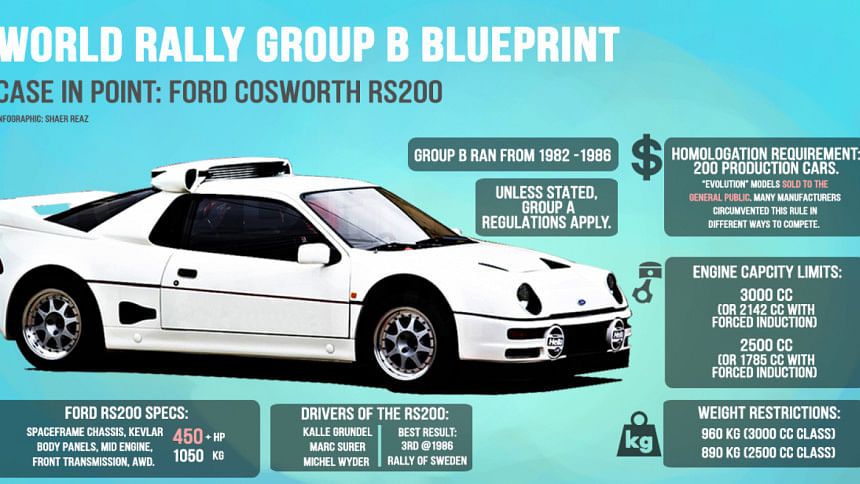
Restrictions
There were virtually no restrictions on how powerful a car could be to compete in Group B. With most of the regulations being brought forward from Group A with a lesser focus on horsepower restrictions, manufacturers such as Audi, Peugeot, Renault and Ford took full advantage and created machines that could take corners at well over 250 km/h. The major restrictions were on engine displacement and on minimum weight, with no specific drivetrain layouts in place.
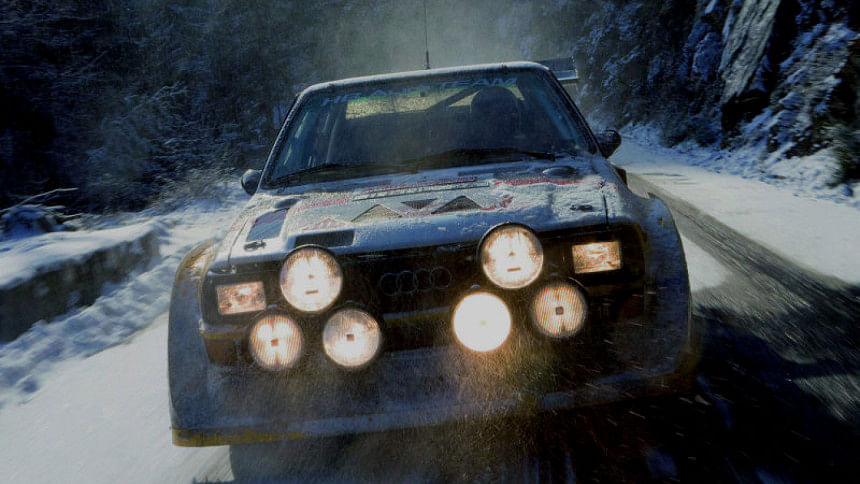
The legends
The cars and drivers received legendary status the moment Group B was outlawed as a motorsport. Lancia's 037 was a supercharged RWD beast that won the 1983 championship at the hands of Walter Rohrl. Audi's infamous Quattro enjoyed the tile of champion in 1982 and 1983, with drivers such as Stig Blomqvist and Michelle Mouton (a lady driver, one of the earliest women to compete in any sort of motorsport, that too at Group B) at the wheel. Ford's RS200 was a mid-engine AWD car that had 450 hp to the wheels and a rear wheel bias and was so ahead of its time that drivers struggled to tame the beast. It never won anything, but it was a punch in the gut for anyone daring enough to drive it, which makes it a legend in our books. Peugeot'S 205 T16 showed the world that a short wheelbase hatchback could wreak havoc both on track and off it. The Renault 5 Turbo and the Rover Metro 6R4 matched it in terms of performance but not racing pedigree. In 1986 a Lancia Delta S4 crashed at the Tour de Corso in the Corsican Rally. What remained were the bodies of driver Henri Toivonen and co-pilot Sergio Cresto. A few hours after the crash, the FIA officially banned Group B.
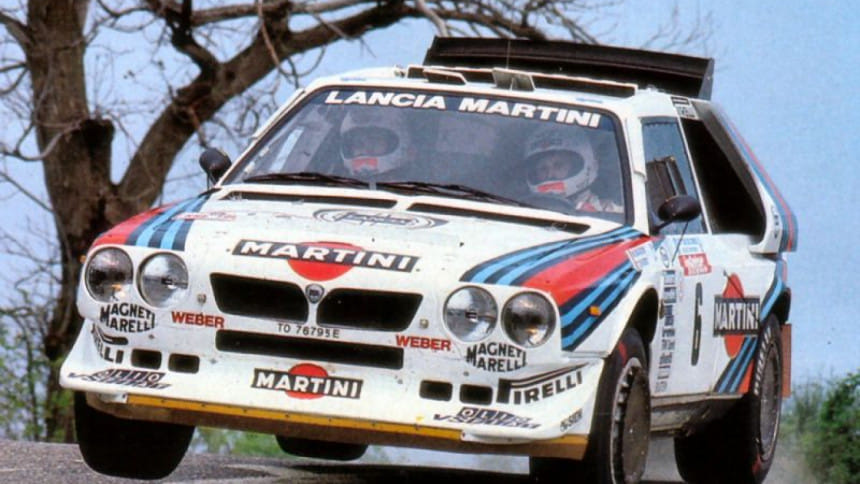
_____________________________________________________________________________________________________________________
Wings, tarmac, horsepower: Time Attack
Mahbub Hussain

We have got to agree F1 is based partially on the car's aerodynamic ability but in terms of pure aerodynamic racing efficiency, time attack cars really are at the cutting edge of technology. And the two day long event at Sydney Motorsport Park WTAC 2015 just concluded with fire spitting results on the 17th of October. Tilton Racing's Garth Waldon's Mitsu Evo 9 held on to his WTAC title for the third consecutive year, only improving his time from 1:24.8412 to 1:23.777.
What is World Time Attack Challenge (WTAC)?
Time Attack, also known as Superlap originated in Japan in the 1980s as a proving ground for street-tuned cars built by highly respected tuning companies. Time attack enjoyed a quick rise in popularity and soon tuner shops started developing purpose-built time attack race cars. Within a short period of time, time attack format has spread throughout the world, with USA, UK, New Zealand and Australia all hosting their own national events respectively.

The inaugural Yokohama World Time Attack Challenge was held in 2010 at the Eastern Creek Raceway (now Sydney Motorsport Park) and proved to be a huge success. It was the first time the likes of PanSpeed, CyberEvo, R-Magic, Cusco, Hi Octane Racing and Sierra Sierra competed against each other at one event. The response from the participants, sponsors, exhibitors, spectators and the media was phenomenal and surpassed everyone's expectations. 2014 saw the introduction of WTAC Live Stream bringing the event to hundreds of thousands of time attack fans around the world and expanding the WTAC brand across all geographical boundaries.
The format
Competitors are divided into four classes- Clubsprint, Open, Pro Am and Pro. During the event each class gets three timed sessions per day (6 in total). The fastest 5 cars in each class at the end of the last session on Day 2 get a bonus round called Superlap Shootout. Superlap Shootout gives another opportunity to the top five cars in each class to improve their time. With the track at optimum temperature and no traffic to negotiate, you are likely to see the fastest times of the event during the Superlap Shootout. Expect flames, sparks and glowing brake rotors as the boost is turned right up in one big grand finale that will be heaven for photographers and fans alike. The team with the fastest overall lap (over the 2 days) in his/her class claims the Class Trophy. The team with the fastest Pro Class lap is declared the WTAC Winner.
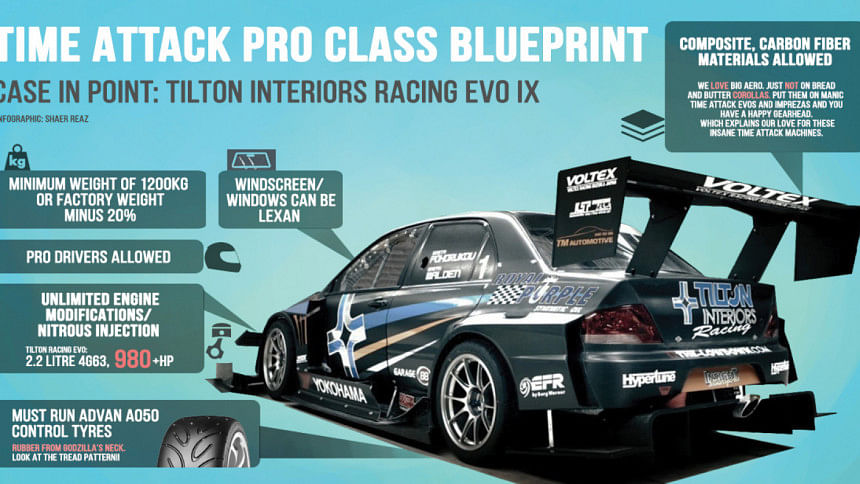
Restrictions
There are severe tyre and aero restrictions on these cars. Depending on classes, you are given finite sets of tyres to use and abuse. There are restrictions on width and make of the tyre- Yokohama Advan Neova and A050 only. These tyres have exceptional wet and dry grip that supports insane fast laps and can be chosen amongst medium to soft compound depending on the class.
The aero limitations are also based on classes. The faster you are in time attack racing the bigger the role your car's aerodynamics will play. While this is especially evident in Pro and Pro Am classes a well thought out aero mods can also have a big impact on a Clubsprint or Open Class car. In a nutshell, aerodynamics is a term to describe how air flows in, out and around a car. The two main factors that affect a vehicle's aero performance are Drag and Lift. The main components of a time attack aero package are front splitters, canards, rear diffusers, rear wings and side skirts. But aero is so much more than just canards, splitters and spoilers. Time attack cars are powered by high horsepower engines and their brakes are working overtime – meaning the path of air through the engine bay is critical. Apart from minimizing drag, creating down force, a well designed aero package should also ensure sufficient cooling of various engine and drive train components.

The results of 2015
2015 results of WTAC have been very similar to 2014 in the first two PRO classes- Garth Waldon held on to his WTAC title in the Royal Purple sponsored PRO class with his 1,000+ HP Evo 9 and Mick Sigsworth also held on to his title in the Garrett turbo sponsored PRO AM class, where Waldon improved his time substantially, Sigsworth's time dropped by fractions of milliseconds (2015's 1:25.757 VS. 2014's 1:25.2760). Both these Evolutions are sick to the eye with devilish aero parts wider than the drivers themselves. A FWD tiny EG Civic hatch from JDM Yard clinched the first place in V-Sport sponsored Open class with Revzone's Evo 9 tailing the Civic with milliseconds of time apart. Both were at 1:30.7 zone. The amateur Clubsprint class was sponsored by Just Car Insurance which drew similar shocking results- BYP Racing's EK Civic hatch with the most minimal aero parts taking the first spot at 1:39.447 with Tunehouse's WRX and SuperPro's EVO tailing it at 1:39.940 and 1:40.086 respectively.



 For all latest news, follow The Daily Star's Google News channel.
For all latest news, follow The Daily Star's Google News channel. 


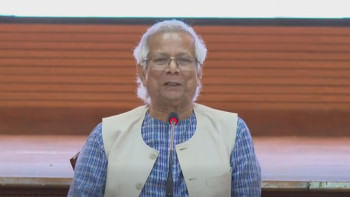
Comments